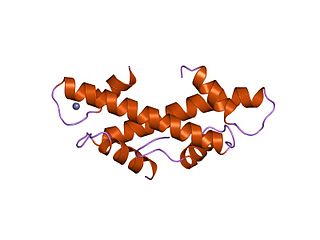Transcription initiation factor TFIID subunit 1, also known as transcription initiation factor TFIID 250 kDa subunit (TAFII-250) or TBP-associated factor 250 kDa (p250), is a protein that in humans is encoded by the TAF1 gene. [5] [6]
Transcription initiation factor TFIID subunit 1, also known as transcription initiation factor TFIID 250 kDa subunit (TAFII-250) or TBP-associated factor 250 kDa (p250), is a protein that in humans is encoded by the TAF1 gene. [5] [6]
Initiation of transcription by RNA polymerase II requires the activities of more than 70 polypeptides. The protein that coordinates these activities is the basal transcription factor TFIID, which binds to the core promoter to position the polymerase properly, serves as the scaffold for assembly of the remainder of the transcription complex, and acts as a channel for regulatory signals. TFIID is composed of the TATA-binding protein (TBP) and a group of evolutionarily conserved proteins known as TBP-associated factors or TAFs. TAFs may participate in basal transcription, serve as coactivators, function in promoter recognition or modify general transcription factors (GTFs) to facilitate complex assembly and transcription initiation. This gene encodes the largest subunit of TFIID. This subunit binds to core promoter sequences encompassing the transcription start site. It also binds to activators and other transcriptional regulators, and these interactions affect the rate of transcription initiation. This subunit contains two independent protein kinase domains at the N and C-terminals, but also possesses acetyltransferase activity and can act as a ubiquitin-activating/conjugating enzyme. Two transcripts encoding different isoforms have been identified for this gene. [5] Histones are often acetylated to open DNA for transcription. TAF1 contains two bromodomains, which each can bind one of two acetyllysine residues at position 5 and 12 in the H4 tail, to stabilize the TBP-TATA box complex.
A mutation in TAF1 was identified that contributes to a phenotype with severe intellectual disability (ID), a characteristic intergluteal crease, and distinctive facial features, including a broad, upturned nose, sagging cheeks, downward sloping palpebral fissures, prominent periorbital ridges, deep-set eyes, relative hypertelorism, thin upper lip, a high-arched palate, prominent ears with thickened helices, and a pointed chin [7] [8] This is a non-synonymous change in TAF1 that results in an isoleucine (hydrophobic) to threonine (polar) change on the 1337th amino acid residue in the protein (NP_001273003.1). Two other mutations were reported in TAF1 in two families with intellectual disability, although further clinical details were not reported. [9]
TAF1 has been shown to interact with:

The TATA-binding protein (TBP) is a general transcription factor that binds specifically to a DNA sequence called the TATA box. This DNA sequence is found about 30 base pairs upstream of the transcription start site in some eukaryotic gene promoters.
Transcription factor II D (TFIID) is one of several general transcription factors that make up the RNA polymerase II preinitiation complex. RNA polymerase II holoenzyme is a form of eukaryotic RNA polymerase II that is recruited to the promoters of protein-coding genes in living cells. It consists of RNA polymerase II, a subset of general transcription factors, and regulatory proteins known as SRB proteins. Before the start of transcription, the transcription Factor II D (TFIID) complex binds to the core promoter DNA of the gene through specific recognition of promoter sequence motifs, including the TATA box, Initiator, Downstream Promoter, Motif Ten, or Downstream Regulatory elements.

Transcription initiation factor TFIID subunit 6 is a protein that in humans is encoded by the TAF6 gene.

Transcription initiation factor TFIID subunit 7 also known as TAFII55 is a protein that in humans is encoded by the TAF7 gene.

TAF9 RNA polymerase II, TATA box binding protein (TBP)-associated factor, 32kDa, also known as TAF9, is a protein that in humans is encoded by the TAF9 gene.

Transcription initiation factor TFIID subunit 12 is a protein that in humans is encoded by the TAF12 gene.

Transcription initiation factor TFIID subunit 4 is a protein that in humans is encoded by the TAF4 gene.

Transcription initiation factor TFIID subunit 2 is a protein that in humans is encoded by the TAF2 gene.

Transcription initiation factor TFIID subunit 10 is a protein that in humans is encoded by the TAF10 gene.

Transcription initiation factor TFIID subunit 5 is a protein that in humans is encoded by the TAF5 gene.

Transcription initiation factor TFIID subunit 11 also known as TAFII28, is a protein that in humans is encoded by the TAF11 gene.

TATA-binding protein-associated factor 2N is a protein that in humans is encoded by the TAF15 gene.

TATA-binding protein-associated factor 172 is a protein that in humans is encoded by the BTAF1 gene.

Transcription initiation factor TFIID subunit 13 is a protein that in humans is encoded by the TAF13 gene.

Transcription initiation factor TFIID subunit 8 is a protein that in humans is encoded by the TAF8 gene.

General transcription factor IIF subunit 1 is a protein that in humans is encoded by the GTF2F1 gene.

TATA box-binding protein-like protein 1 is a protein that in humans is encoded by the TBPL1 gene.

Transcription initiation factor TFIID subunit 9B is a protein that in humans is encoded by the TAF9B gene.

Transcription initiation factor TFIID subunit 4B is a protein that in humans is encoded by the TAF4B gene.

The TBP-associated factors (TAF) are proteins that associate with the TATA-binding protein in transcription initiation. It is a part of the transcription initiation factor TFIID multimeric protein complex. It also makes up many other factors, including SL1. They mediate the formation of the transcription preinitiation complex, a step preceding transcription of DNA to RNA by RNA polymerase II.
This article incorporates text from the United States National Library of Medicine, which is in the public domain.